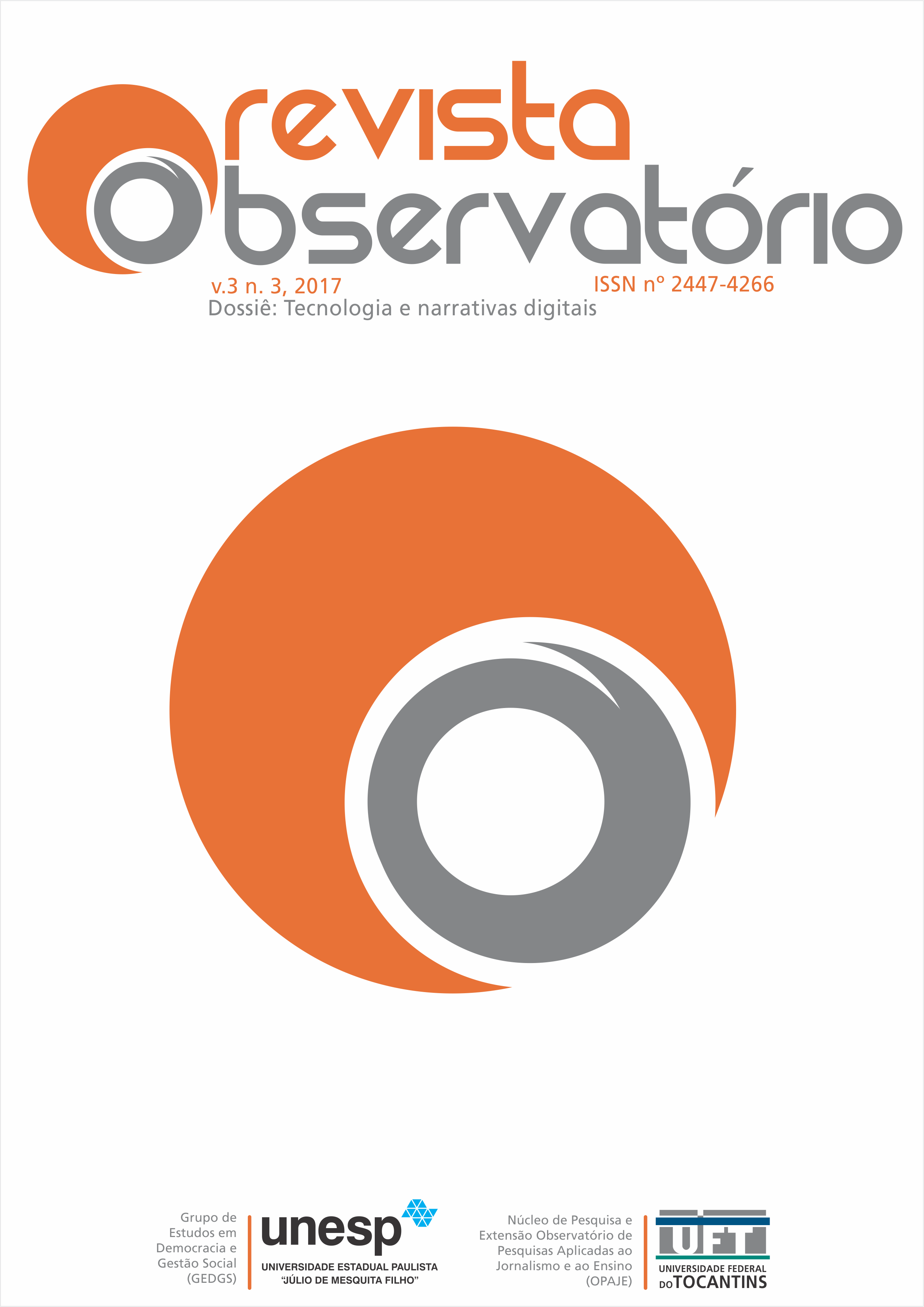DESAFIOS DO JORNALISMO EM AMBIENTE COMUNICACIONAL SIMBIÓTICO ESTRUTURADO PELA COMPUTAÇÃO COGNITIVA
DOI :
https://doi.org/10.20873/uft.2447-4266.2017v3n3p34Mots-clés :
jornalismo, computação cognitiva, simbiose homem-máquina, narrativasRésumé
O Jornalismo sofreu forte influência tecnológica oriunda da Revolução Industrial. Séculos depois, outro grande impacto atingiu os seus modos de fazer, a introdução das máquinas computacionais e redes telemáticas, que baseiam a relação homem-máquina computacional na filosofia cibernética denominada master-slave. Outra vertente tecnológica a compor o atual ecossistema informativo digital conectado, a Computação Cognitiva, é baseada no artigo seminal de J.C.R. Licklider, Man-computer Symbiosis (1960). A relação entre homem-máquina computacional, nessa linha tecnológica cognitiva, é de parceria na troca de informações de forma simétrica entre dois agentes cognitivos, um biológico (ser humano) e outro sintético (máquina computacional), que desafiará Jornalismo para adoção de novos tipos de relacionamento com a audiência.
Téléchargements
Références
ANDERSON, C. W.; BELL, E.; SHIRKY, C. Post-Industrial Journalism : adapting to the present. New York: [s.n.]. Disponível em: <http://towcenter.org/research/post-industrial-journalism/>.
BIRKHOFF, G. Computing Developments 1935-1955, as seen from Cambridge, U.S.A. In: HOWLETT, J.; ROTA, G.-C. (Eds.). . A history of computing in the twentieth century. New York: Academic Press, Inc, 1980. p. 21–30.
COLE, S. IBM Watson Created The First-Ever AI-Made Movie.
DIAKOPOULOS, B. N.; PH, D. Cultivating the Landscape of Innovation in Computational Journalism. n. April, 2012.
FRANKEL, S. Creating Exceptional Software to Enhance Human Productivity. Disponível em: <https://www.narrativescience.com/about-us>. Acesso em: 31 mar. 2017.
FU, W.-T. The Central Role of Heuristic Search in Cognitive Computation Systems. Minds and Machines, v. 26, n. 1, p. 103–123, 2016.
FULLER, J. What is happening to news. Chicago: The University of Chicago Press, 2010.
GRAEFE, A. Guide to Automated JournalismNew YorkTow Center for Digital Journalism, , 2016. Disponível em: <https://www.gitbook.com/book/towcenter/guide-to-automated-journalism/details>
GREITZER, F. L.; GRIFFITH, D. A Human-Information Interaction Perspective on Augmented Cognition. Augmented Cognition International Conference. Anais...São Francisco: 2006
GRIFFITH, D. Neo-symbiosis: A Conceptual Tool for System Design. Proceedings of the 40th Hawaii International Conference on System Sciences. Anais...Ieee, 2007
KELLY III, J. E. Smart Machines: IBM’s Watson and the Era of Cognitive Computing. [s.l.] Columbia Business School Publishing, 2013.
LICKLIDER, J. C. R. Man-Computer Symbiosis. IRE Transactions on Human Factors in Eletronics, p. 4–11, 1960.
LICKLIDER, J. C. R.; TAYLOR, R. W. The computer as a communication device. Science and Technology, n. September, p. 20–41, 1968.
LIMA JUNIOR, W. T. Mídia digital: o vigor das práticas jornalísticas em um novo espaço. [s.l.] Universidade de São Paulo, 2003.
LIMA JUNIOR, W. T. Recommendation Systems that Establish new Forms of Representational Reality: Eliminating the Dividing Line between Information Emitter and Receptor of Journalistic Information. The International Journal of Interdisciplinary Social Sciences, v. 6, n. 3, p. 289–296, 2011.
MODHA, D. S. et al. Cognitive computing. Communications of the ACM, v. 54, p. 62, 2011.
MUSSON, A. E. Newspaper printing in the Industrial Revolution. The Economic History Review, v. 10, n. 3, p. 411–426, 1958.
NIKKI USHER, S. C. L. Open source and journalism: Toward new frameworks for imagining news innovation. Paper presented to the Journalism Studies Division of the International Communication Association. Anais...2012
PAVLIK, J. V. Cognitive computing and journalism: implications of algorithms, artificial intelligence and data for the news media and society. Brazilian Journal of Technology, Communication, and Cognitive Science, v. 4, n. December 2016, p. 1–14, 2016.
RICCARDI, G. Towards Healthcare Personal Agents. Workshop on Roadmapping the Future of Multimodal Interaction Research including Business Opportunities and Challenges. Anais...2014
SARKAR, S.; ZAHARCHUK, D. Your cognitive future. [s.l: s.n.]. Disponível em: <http://www.ibm.com/services/multimedia/GBE03642USEN.pdf>.
SILVA, J. R.; LIMA JUNIOR, W. T. From Licklider to cognitive service systems. XX Brazilian International Meeting on Cognitive Science. Anais...2015
TAYLOR, J. G. Cognitive Computation. Cognitive Computation, v. 1, n. January, p. 4–16, 2009.
Téléchargements
Publié-e
Comment citer
Numéro
Rubrique
Licence
[PT] Autores que publicam nesta revista concordam com os seguintes termos:
1. Autores mantém os direitos autorais e concedem à revista, sem pagamento, o direito de primeira publicação, com o trabalho simultaneamente licenciado sob a Creative Commons Attribution License (CC BY-NC 4.0), permitindo o compartilhamento do trabalho com reconhecimento da autoria do trabalho e publicação inicial nesta revista.
Leia todos os termos dos direitos autorais aqui.

